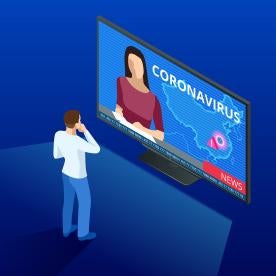In a surprise move, Federal Communications Commission (FCC) Chairman Ajit Pai joined up last week with Department of Homeland Security Cybersecurity and Infrastructure Security Agency (CISA) Director Christopher Krebs to write to the governors of the 50 states as well as U.S. Territories (including the District of Columbia mayor) urging them all to recognize communications networks and services—including Internet access, broadcast and radio, and satellite services, among others—as essential to Covid-19 response efforts. Chairman Pai and Director Krebs went on to urge the governors to provide communications workers with “the requisite access and resources needed to keep Americans connected during the COVID-19 pandemic.”
The letter comes at a time when, as all of us have become increasingly aware, communications networks provide the vital broadband connectivity that has allowed many of us to work and function through the pandemic closures and have provided the backbone for e-commerce, telework, entertainment, telehealth, and distance learning. We used to talk about the importance of keeping the lights on. Now it’s all about staying connected and online via broadband.
As readers of this blog and followers of what we now like to call our statereopenings.com project (or what we called in early pandemic days, stateclosures.com) likely know, the list of critical infrastructure industries developed by CISA, what has been dubbed the CISA List, already includes the communications sectors. Indeed, the CISA List has been the centerpiece of the closure orders of 20 or so states and the District of Columbia and the benchmark for essential sectors that could remain open under a particular state’s COVID-19 closure and stay at home directives.
So what does the FCC/CISA letter say, and why does it come now, when, all but a few states are firmly in the reopening camp? With the focus now shifting from business closures to how safely to reopen particular businesses, some might argue that the distinction between critical infrastructure industries and the rest of the economy, at least as to closure requirements, is of reduced significance compared to when most of the country was under strict closure and stay at home orders.
So let’s first take a look at what the FCC/CISA letter says, and then we can unpack it a bit. Basically, the letter comprises six recommendations, including:
-
Reviewing the CISA List and Guidelines for Emergency Calling 911 Centers.
-
Reminding the governors that certain communications infrastructure and entities have been deemed “essential” and, as such, be afforded “all appropriate resources and access.”
-
Distributing personal protective equipment, or PPE, to communications personnel when available.
-
Understanding that communications providers’ retail customer service personnel at service center locations are critical to customers’ emergency communications needs.
-
Encouraging providers and governments to cooperate in next-generation 911 projects.
-
Providing online access to relevant government functions, such as the permitting process, in order to facilitate the maintenance, repair, and provisioning of communications infrastructure and services.
As noted, the letter comes at a time when all but a handful of these jurisdictions have started the re-opening process and are easing up on their respective COVID-19 closings and restrictions. Despite communications services being deemed “essential,” those restrictions apparently posed various challenges earlier in the pandemic to communications providers and workers in connecting customers with the services they need and request.
At the time that the pandemic began spreading rapidly throughout the U.S. in March, states and territories began declaring states of emergency and imposing their own stay-at-home and business closure orders and restrictions (e.g., PPE, social distancing), which included disparate definitions of “essential” or “critical” business and/or services that could remain operational during the state of emergency. Many states, as noted, incorporated the CISA List, while others came up with their own lists.
Still, during that time, the FCC apparently had been hearing from communications service providers complaining of various logistical issues with getting customers connected in terms of gaining necessary access to various customers and premises safely and in conformance with each jurisdiction’s orders. Of course, retail locations around the country faced widespread closures, and this included those of wireless carriers that closed many retail locations early in the pandemic. Those remaining open were subject to reduced hours and operations.
Even as states and territories transition out of their stay-at-home and business closure modes in phased increments, the varying definitions of what is considered “essential” or “critical” can still apply, and in many cases PPE and social distancing restrictions can be strictly enforced. Moreover, jurisdictions feasibly could re-impose stay-at-home and business closure measures to the extent COVID-19 in particular areas undergoes a resurgence or spike following widespread reopenings across the economy, relaxed social distancing and protective measures, and increased public gatherings.
The FCC/CISA letter certainly gives communications providers a visibility boost in demonstrating the importance of their services, and the agencies indicate that they “remain available to work with both government and service providers to meet critical communications needs” during the pandemic crisis. For example, what actually constitutes “appropriate resources and access” is not defined in the letter, but having two federal agencies urging state governors to provide all appropriate resources and access to communications providers certainly gives communications providers an opportunity to make requests for particular resources and access, broadly construed, where necessary to their mission (again, broadly construed) or for the elimination of impediments to repair maintenance, and upgrades. In other words, strike while the iron’s hot.
The admonition of the agencies that providers and governments should cooperate in next-generation 911 projects, is another great example. It is not exactly clear why the pandemic provides a particular reason, in and of itself, for prioritizing and cooperating on next-generation 911 projects, but advancing these projects–whatever the circumstance—makes good public policy sense. As many have said over these past months, “Why let a good crisis go to waste?”
Of course, beyond establishing a federal posture on the recommended role of communications providers in responding to COVID-19, the agencies have no specific authority or enforcement mechanism to exert further influence on the states and territories to follow through on these requests. But that was probably not the point. Rather, the letter was an example of the federal government using its bully pulpit to create support and awareness around an important public policy agenda, leaving it to providers and their advocates, who no doubt had some role in its creation, to make creative use of the letter to keep their networks humming.





 i
i


